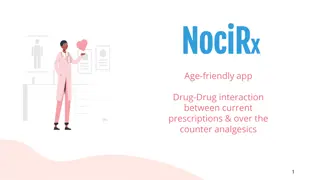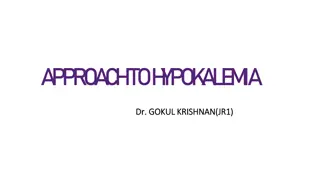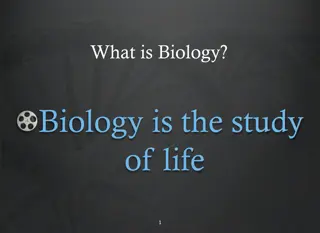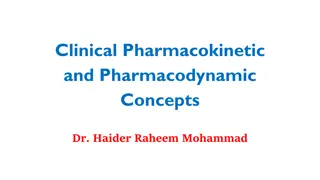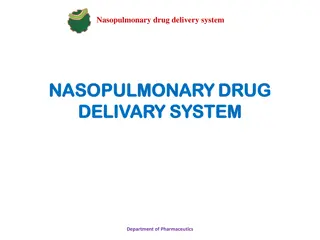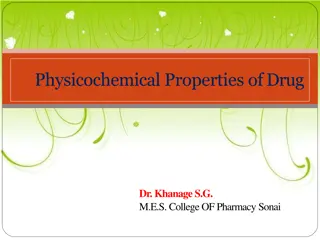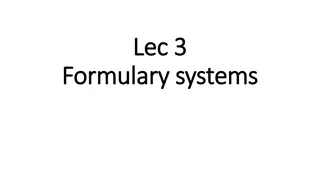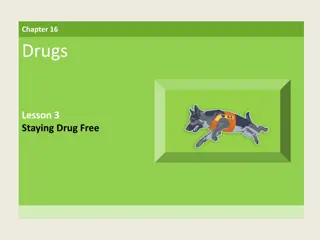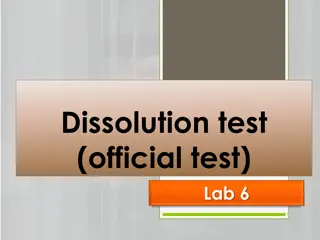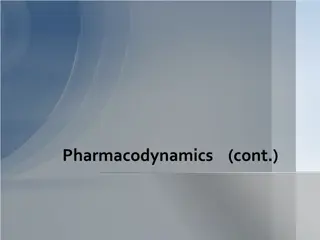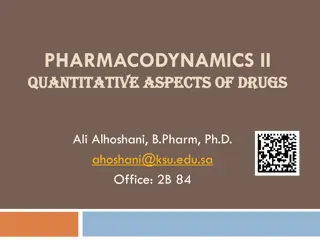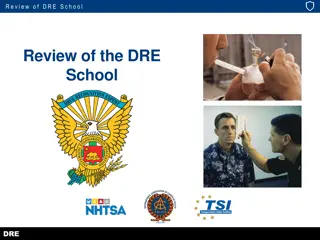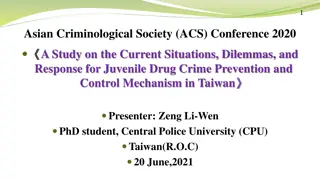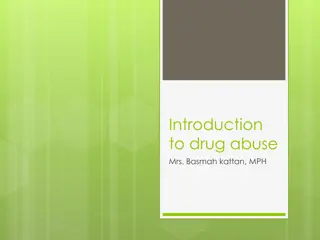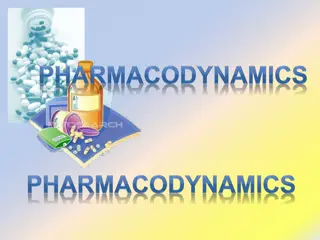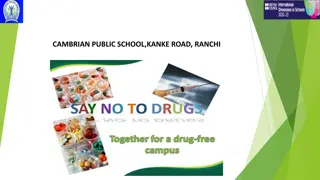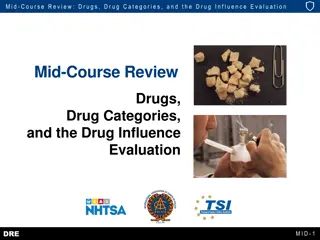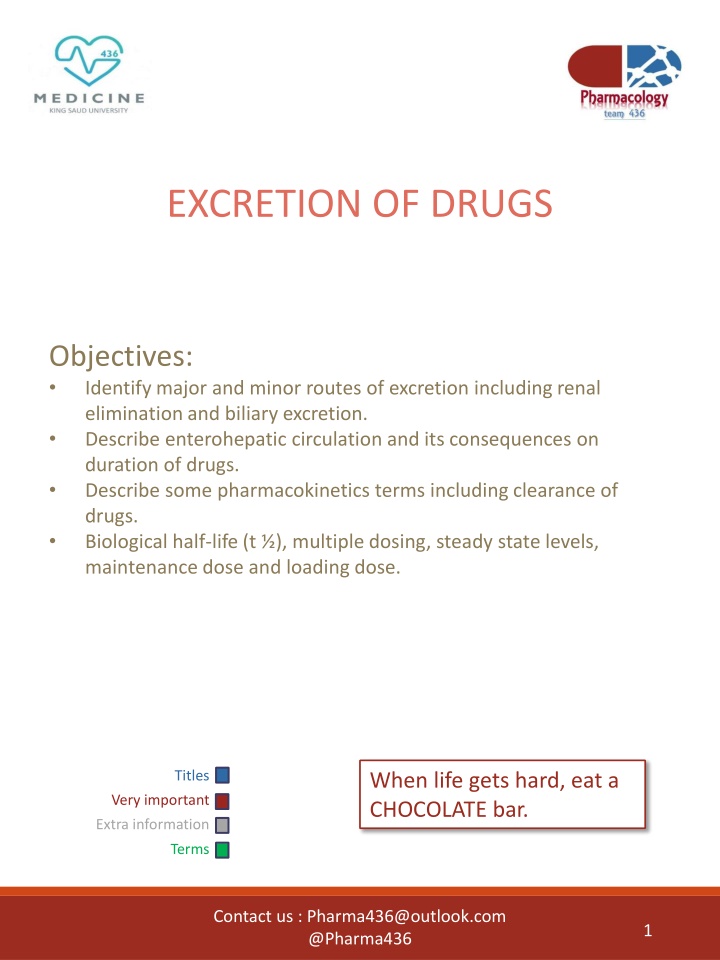
Drug Excretion: Routes and Processes Revealed
Explore the major and minor routes of drug excretion, including renal and biliary pathways. Learn about urinary pH trapping, renal excretion, and important pharmacokinetics terms. Discover how drugs are eliminated from the body through various mechanisms.
Download Presentation

Please find below an Image/Link to download the presentation.
The content on the website is provided AS IS for your information and personal use only. It may not be sold, licensed, or shared on other websites without obtaining consent from the author. If you encounter any issues during the download, it is possible that the publisher has removed the file from their server.
You are allowed to download the files provided on this website for personal or commercial use, subject to the condition that they are used lawfully. All files are the property of their respective owners.
The content on the website is provided AS IS for your information and personal use only. It may not be sold, licensed, or shared on other websites without obtaining consent from the author.
E N D
Presentation Transcript
EXCRETION OF DRUGS Objectives: Identify major and minor routes of excretion including renal elimination and biliary excretion. Describe enterohepatic circulation and its consequences on duration of drugs. Describe some pharmacokinetics terms including clearance of drugs. Biological half-life (t ), multiple dosing, steady state levels, maintenance dose and loading dose. Titles When life gets hard, eat a CHOCOLATE bar. Very important Extra information Terms Contact us : Pharma436@outlook.com @Pharma436 1
Routes of Excretion Minor Major Pulmonary excretion. Salivary excretion. Mammary excretion via milk. Skin / Dermal excretion via sweat. Tears Renal Excretion Biliary Excretion 1 4 2 The structure unit of kidney is nephron That consists of : 1-Glomerulus 2-Proximal convoluted tubules 3-Loop of Henle 4-Distal convoluted tubules 5-Collecting ducts 5 3 Contact us : Pharma436@outlook.com @Pharma436 2
The principle processes that determine the Urinary excretions of drugs are : Glomerular filtration (GFR): Active tubular secretion: Passive tubular re- absorption: Depends upon renal blood flow (600 ml/min). Glomerular filtration rate (GFR) is about 20% of renal blood flow = 125 ml/min. It occurs to: 1- low molecular weight drugs . 2- Only free drugs (unbound to plasma proteins) are filtered. + 3- Water soluble molecules ( Polar ionized). Occurs mainly in proximal tubules; increases drug. concentration in lumen. Organic anionic and cationic transporters mediate active secretion of anionic and cationic drugs. Can transport drugs against conc. gradients. e.g. Penicillin. In distal convoluted tubules & collecting ducts. Passive diffusion of unionized, lipophilic drugs Lipophilic drugs can be reabsorbed back into blood circulation from tubular lumen and excretion in urine will be low. Ionized drugs are poorly reabsorbed so urinary excretion will be high. Contact us : Pharma436@outlook.com @Pharma436 3
System for acidic drugs. Salicylates Penicillin (Asprin) Sulphonamids Transport of acidic drugs is blocked by probenecid System for basic drugs. Morphine Neostigmine Atropine Quinine The ine at the end of the name means that the drug is basic Contact us : Pharma436@outlook.com @Pharma436 4
Urinary pH trapping (Ion trapping) Urinary pH trapping (Ion trapping) Changing pH of urine by chemicals can inhibit or enhance the drug reabsorption from renal tubules back into blood circulation. Ion trapping is used to enhance renal clearance of drugs during toxicity. Urine is normally slightly acidic and favors excretion of basic drugs. Acidification of urine using ammonium chloride (NH4Cl) increases excretion of basic drugs as amphetamine. Alkalinization of urine using sodium bicarbonate (NaHCO3)increases excretion of acidic drugs as aspirin. Renal Excretion Biliary Excretion Occurs to few drugs that are excreted into feces. Drugs excreted mainly by the kidney include: Aminoglycosides antibiotics (as gentamycin) Penicillin Lithium These drugs should be prescribed carefully in: Such drugs are secreted from the liver into bile by active transporters, then into duodenum. Some drugs undergo enterohepatic circulation back into systemic blood circulation. Patients with renal disease Elderly Contact us : Pharma436@outlook.com @Pharma436 @Pharma436 Contact us : Pharma436@outlook.com 5
Extra notes Lippincott s corner Renal elimination of a drug: Elimination of drugs via the kidneys into urine involves the three processes of Glomerular filtration, Active tubular filtration and passive tubular reabsorption. 1. Glomerular filtration: drug enter the kidney through renal arteries, which divide to form a capillary plexus. Free drugs flows through the capillary slits into bowman s space as part of glomerular filtration. The glomerular filtration rate (125mL/min) is normally about 20% of the renal plasma flow (600 mL/min). Lipid solubility and pH do not influence the passage of drugs into the glomerular filtration rate and plasma binding of the drugs may affect this process. 2. Proximal tubular secretion: drugs that were not transferred into the glomerular filtrate leave the glomeruli through efferent arterioles, which divide to form capillary plexus surrounding the nephric lumen in the proximal tubule. Secretion primarily occurs in the proximal tubule by two energy-requiring active transport (carrier requiring) systems: one for anions (for example: deprotonated forms of weak acids) and one for cations (for example: protonated forms of weak bases). Each of these transport systems shows low specificity and can transport many compounds. Thus, competition between drugs for these carriers can occur within each transport system. { NOTE: premature infants and neonates have an incompletely developed tubular secretory mechanism, thus , may retain certain drugs in the glomerular filtrate}. 3. Distal tubular reabsorption: as drug move toward distal convoluted tubule, its concentration increases and exceeds that of the perivascular space. The drug, if uncharged, may diffuse out of the nephric lumen, back into systemic circulation. Manipulating the pH of the urine to increase the ionized form of the drug in the lumen may be done to minimize of back diffusion and, hence, increase the clearance of an undesirable drug. As a general rule, weak acids can be eliminated by alkalinization of the urine, whereas elimination of weak bases may be increased by acidification of the urine. This process called ion trapping . For example, patient present with phenobarbital (weak acid) overdose can be givin bicarbonate, which alkalinizes the urine and keeps the drug ionized, thereby decreasing its reabsorption. If overdose is with a weak base, such as amphetamine, acidification of the urine with NH4Cl leads to protonation of the drug (that is, it becomes charged) and an enhancement of its renal excretion. 4. Role of drug metabolism: most drugs are lipid soluble and, without chemical modification, would diffuse out of the kidney s tubular lumen when the drug concentration in the filtrate becomes greater than in the perivascular space. To minimize this reabsorption, drugs are modified primarily in the liver into more polar substances using two types of reaction: Phase 1 reaction which involve either the addition of hydroxyl groups or the removal of blocking groups from hydroxyl, carboxyl, or amino groups, and phase 2 reaction that use conjugation with sulfate, glycine, or glucuronic acid to increase drug polarity. The conjugation are ionized, and the charged molecules cannot back-diffuse out of the kidney lumen. Contact us : Pharma436@outlook.com @Pharma436 6
Biliary Excretion o Occurs to few drugs that are excreted into feces . o Such drugs are secreted from the liver into bile by active transporters, then into duodenum (intestine) . o Some drugs undergo enterohepatic circulation back into systemic blood circulation. Enterohepatic circulation Drugs excreted in the bile in the form of glucouronides will be hydrolyzed in intestine by bacterial flora liberating free drugs that can be reabsorbed back into blood if the drugs are lipid soluble. This prolongs the duration of action of drugs e.g. digoxin, morphine, thyroxine. Contact us : Pharma436@outlook.com @Pharma436 7
Excretion Summary Plasma half-life (t ) It Is the time required for the plasma concentration of a drug to fall to half of its initial concentration. SO SO It It Is a measure of duration of action. AND It Determine the dosing interval. Drugs of short plasma half life Penicillin , tubocurarine. Drugs of long plasma half life Digoxin , Thyroxine. Factors May Increase Plasma half-life (t ): 1-Decreased metabolism Liver disease. Microsomal inhibitors. 2-Decreased clearance Renal disease. Congestive heart failure. 3-High binding of drugs Plasma proteins. Tissue binding. 4-Enterohepatic recycling Contact us : Pharma436@outlook.com @Pharma436 8
Steady state:- A state at which the therapeutic plasma concentration of the drug (mg/ml) remains constant with the therapeutic window (the range between effective and toxic levels of drugs). -At steady , drug administration = drug elimination Therapeutic Window: ( The range at which the state of the drug is steady, (drug in= drug out) without reaching toxicity level ) *Steady state concentration is attained after 3-5 half lives e.g. morphine. t1/2 can be used to predict how long it will take from the start of dosing to reach steady-state levels during multiple dosing. Contact us : Pharma436@outlook.com @Pharma436 @Pharma436 Contact us : Pharma436@outlook.com 9
Loading dose is the large initial dose that is given to achieve rapid therapeutic plasma level (Steady State ). These doses balances the drug distribution balances the drug distribution . This is important for drugs with long halve lives. After administration of the drug , the plasma concentration decreases due to distribution of drug to other tissues. Loading dose = Volume of distribution x plasma drug conc. rapid therapeutic plasma level Clinical Application of Loading Dose if the time required to attain ( A loading dose may be desirable ( steady state of drug is long and rapid relief is required in the condition being treated. E.g. t1/2 of lidocaine (antiarrhythmic drug) is usually 1-2 hours. Arrhythmias after myocardial infarction are life after myocardial infarction are life- -threatening threatening , and one cannot wait 4-8 hours to achieve a therapeutic concentration. Arrhythmias Use of a loading dose of lidocaine in the coronary care unit is standard. Maintenance Doses are the doses required to maintain the therapeutic level of the drug constant or the steady state of the drug. These doses balance the amount of drug lost during metabolism and clearance clearance. during metabolism and The patient needs to take regular doses of a drug such as amoxicillin ( mg) / mg) / 8 8 hours to maintain the therapeutic level hours to maintain the therapeutic level. amoxicillin ( 500 500 Maintenance dose =Clearance x Plasma concentration Contact us : Pharma436@outlook.com @Pharma436 10
Loading dose and Maintenance Doses 3 2 1 1-Loading dose : is the large initial dose that is given to achieve rapid therapeutic plasma level (Steady State ). 2-After administration of the drug, the plasma concentration decreases due to distribution of drug to other tissues. 3-Maintenance Doses : are the doses required to maintain the therapeutic level of the drug constant or the steady state of the drug. We strongly suggest to read Lippincott s Page 19-23 Contact us : Pharma436@outlook.com @Pharma436 11
Quick exam Contact us : Pharma436@outlook.com @Pharma436 12
Pharmacology Team : Boys Girls Contact us : Pharma436@outlook.com @Pharma436 13

